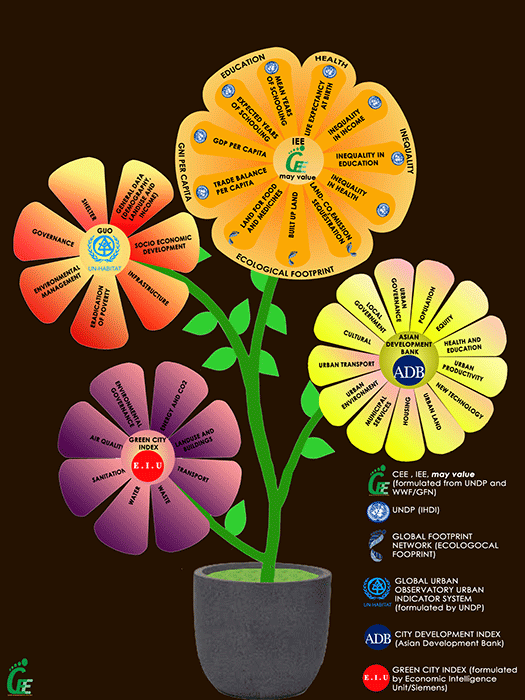WORLD URBAN INDICATOR SYSTEMS
A serious problem associated with environmentally-efficient development management is the lack of organised data for efficient evaluation and monitoring. There is an urgent need for capacity building at the local level. Collection of data, creation of statistics, and formulation of indicators and indices to enable monitoring, evaluation and comparison is the need of the hour. They are useful tools to arrive at corrective policies, programs and projects at from Global to Local to meet SUSTAINABLE DEVELOPMENT GOALS.
INDICATOR INITIATIVES
GLOBAL URBAN OBSERVATORY(GUO) PROGRAM OF UN-HABITAT
The United Nations Conference on Environment and Development (UNCED), the Earth Summit, held in Rio de Janeiro, 1992 was attended by 120 heads of state. A large number of documents on various issues concerning mankind and to save the earth were prepared for global action. The action program called upon countries, particularly developing countries to initiate programs in the area of governance for sustainable development. The program covered various aspects like capacity building, fine-tuning of the existing institutional framework, good governance, need for better policy formulation and improved planning and management of the environment. Initiation of CSD indicators of sustainable development was one of the major outcomes of the UNCED. The key areas of CSD indicator framework are Social, environmental, economic and institutional. In the Habitat II conference held in Instanbul (1996) member countries committed themselves to implement the Habitat Agenda through policy and plans of action designed at each level in cooperation with all interested partners. All partners were asked to monitor and evaluate their performance in working towards adequate shelter for all and sustainable development in an urbanizing world. United Nations Centre for Human Settlements (UNCHS) in close partnership with the United Nations Development Program(UNDP), World Bank and other Organisations conceived and developed Urban Indicators Program (UIP). The emphasis of UIP is adopting a partnership approach involving decision-makers at the government level and stakeholders who have an interest in urban development issues. The program was envisaged to be implemented through the setting up of a system of observatories at the global, regional, national and local levels. The key areas of Urban Indicator Framework are
- Socio-economic development
- Infrastructure
- Transportation
- Environmental Management
- Governance and Housing
Setting up of an indicator system for efficiency evaluation at city/metropolitan area and carrying capacity evaluation at the regional level is highly essential for decision making and policy formulation to guide the development in the optimum path.
ASIAN DEVELOPMENT INDEX OF ASIAN DEVELOPMENT BANK (ADB)
Asian Development Bank has introduced the Asian City Index in which the following key indicators have been incorporated.
- Population
- Equity
- Health & Education
- Urban Productivity
- New Technology
- Urban Land
- Housing
- Municipal Services
- Urban Environment
- Urban Transport
- Local Governance
- Urban Governance
GREEN CITY INDEX INTRODUCED BY ECONOMIC INTELLIGENT UNIT(E.I.U)
Key indicators incorporated are coming under the following heads
- Energy and CO2
- Landuse and Buildings
- Transport
- Waste
- Water
- Sanitation
- Air Quality
- Environmental Governance
ENVIRONMENTAL EFFICIENCY IMPROVISED AS ‘may value’ propagated by CENTRE FOR ENVIRONMENTAL EFFICIENCY
This is an evaluation system in which inequality-adjusted human development (IHDI) is calculated with respect to the ecological footprint(EFpI). IHDI calculations are owned by the UNDP while the Ecological Footprint Calculations are owned by World Footprint Network instituted by Dr Mathis Wackernagel.
Factors incorporated in the ‘may value’ calculations are
- Life expectancy at birth indicative of the health status
- Mean Years of Schooling and Expected Years of schooling indicative of the educational status
- GDP per capita and Trade Balance per capita indicative of the economics and income status
- Land needed for food and medicine, built-up land and land for CO2 sequestration indicative of the total consumption
- Adjustments for inequality for health, education and income indicative of the equity status
The word ‘may’ stands for WISH-PRAYER-HOPE













